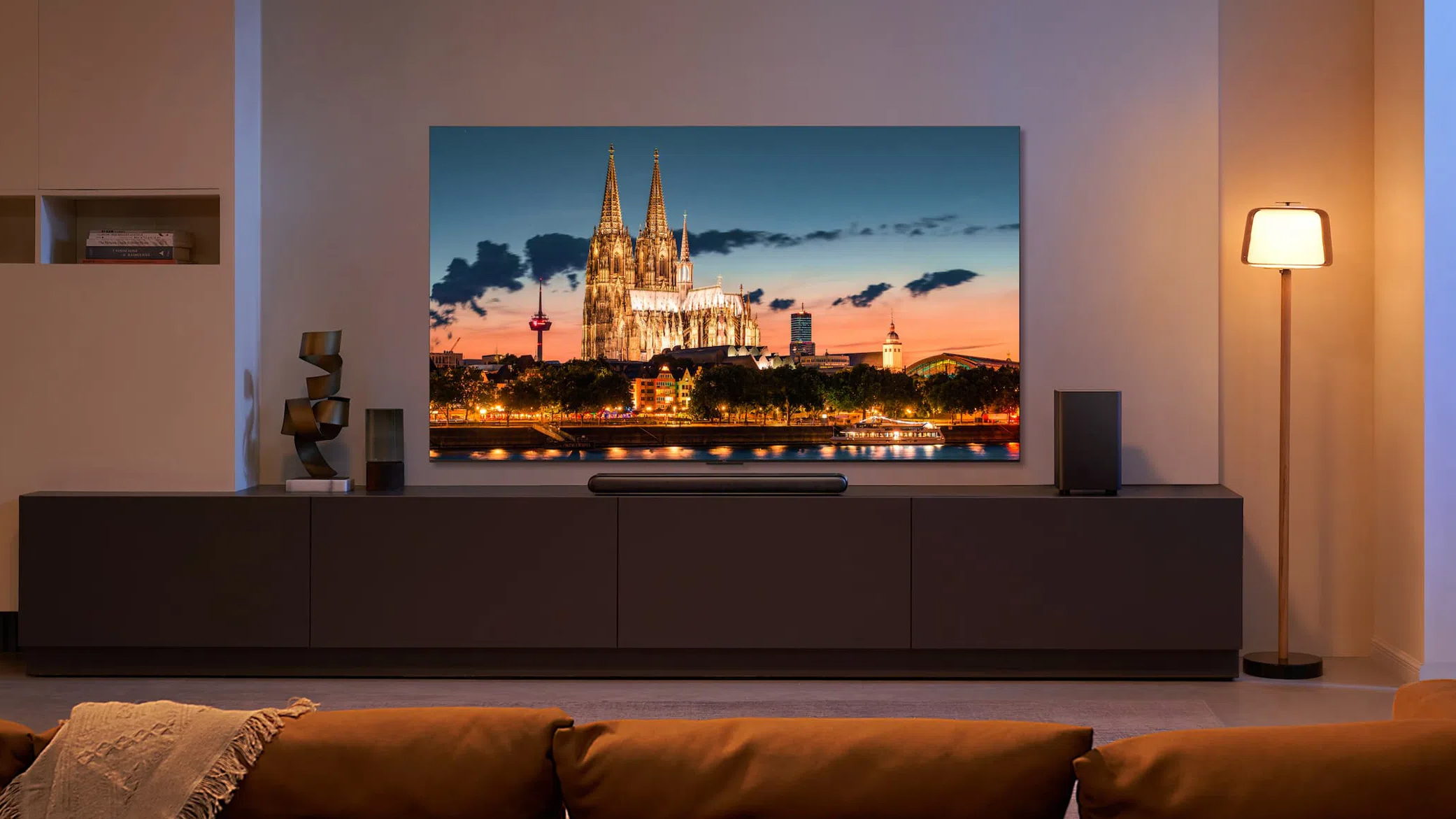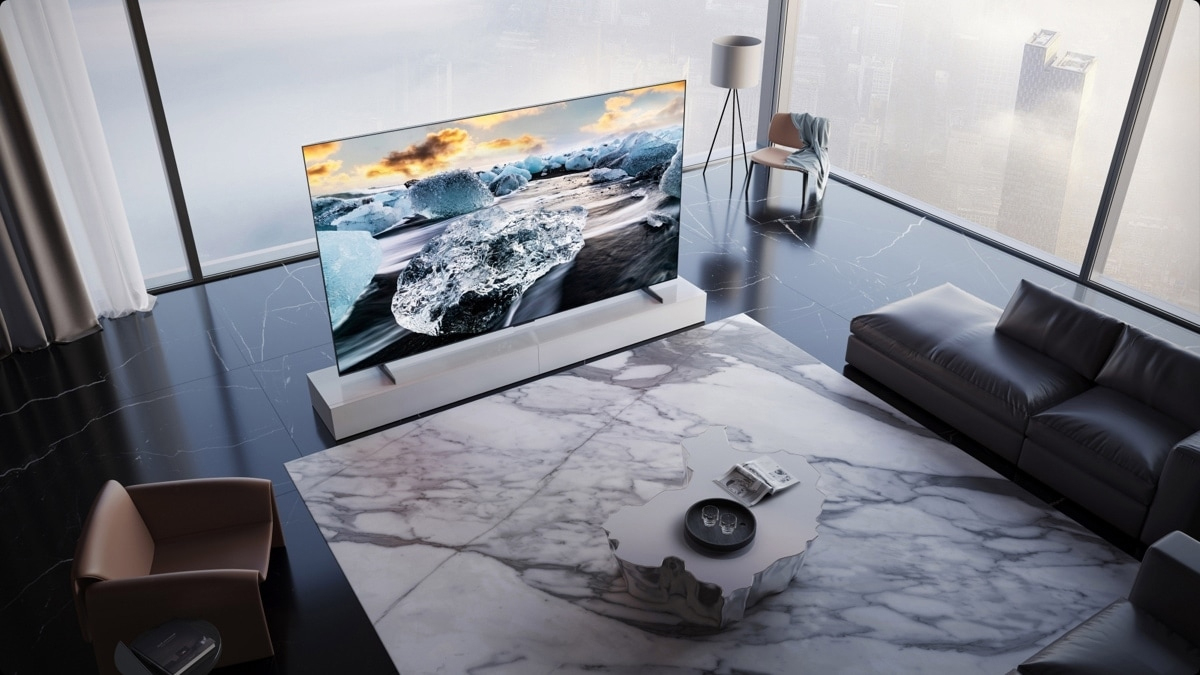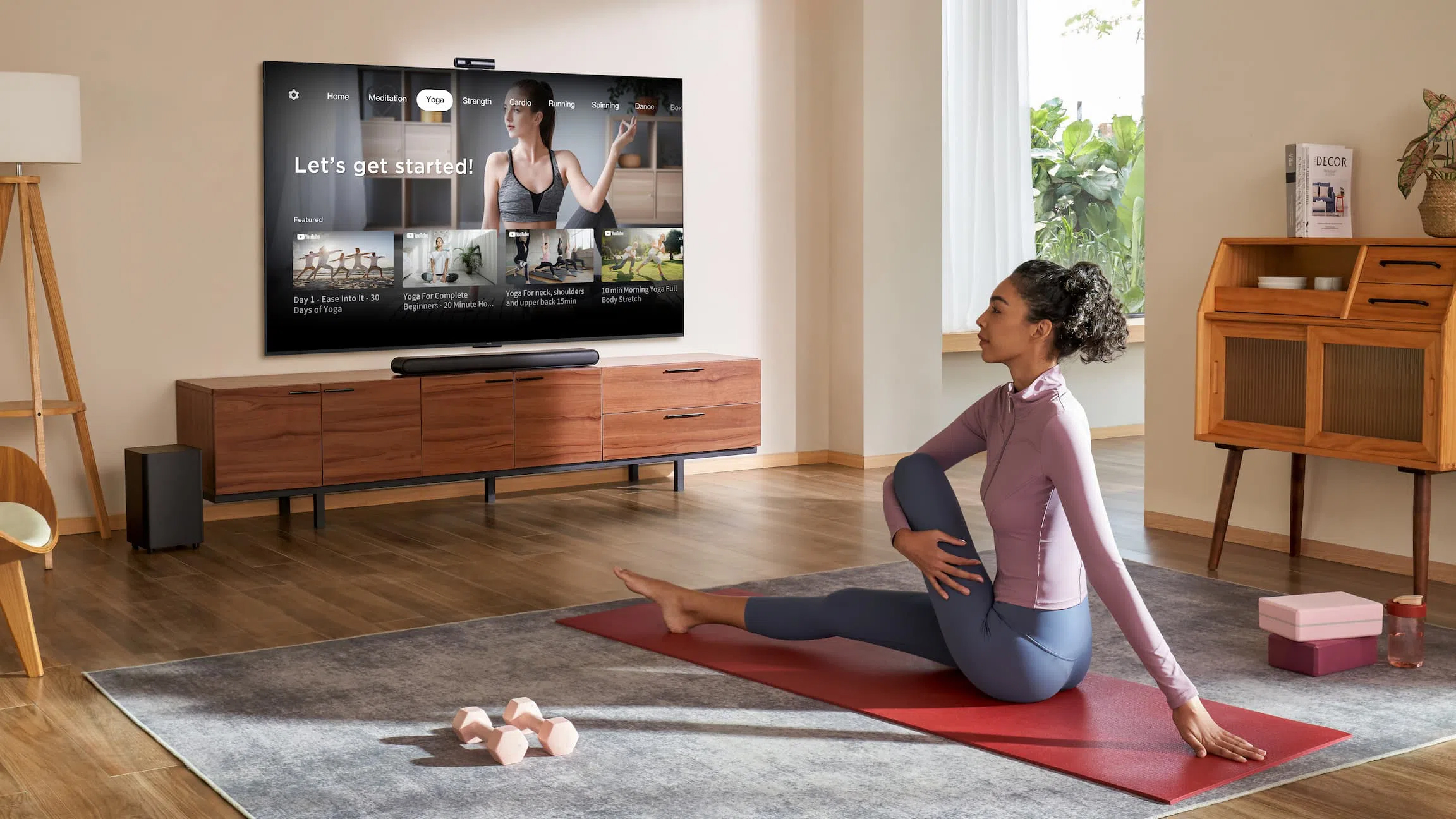

The Samsung QN90D and TCL C855 are both 4K TVs with Mini-LED type panels, that sit in the upper mid-range of their respective brands' line-ups. While the basic design and specifications aren’t dissimilar, the better-known Samsung brand emphasises performance at a premium, while newer TCL is more focused on hitting a lower price point.
This raises an interesting dilemma: does Samsung’s superior picture know-how justify its price premium over the more affordable but possibly not as sophisticated TCL? Wanting to know for sure, we nipped off to a top-secret location and checked out the QN90D and C855 side-by-side, with an emphasis on objective testing of picture quality. Here's what we made of the two options.
Screen Sizes & Pricing
The Samsung QN90D is one of the more affordable of the brand’s 2024 TVs, with competitive pricing and screens to meet every need. There’s 43-inch (£999), 50-inch (£1,099), 55-inch (£1,299), 65-inch (£1,749), 75-inch (£2,599), 85-inch (£4,199) and 98-inch (£7,999) screen sizes.
Conversely, the TCL C855 is at the higher-end of the brand’s line-up, with the focus on larger screen sizes but at more affordable prices. It’s go big or go home with the C855, which offers 65-inch (£1,299), 75-inch (£1,699), 85-inch (£2,089) and 98-inch (£3,999) screen sizes.
For the purposes of this article I directly compared and fully tested the 75-inch models: the Samsung 75QN90D and TCL 75C855.
All the objective testing was conducted using Portrait Displays’ C6 HDR5000 colour meter, VideoForge Pro pattern generator, and Calman calibration software – so there are figures to back up our thinking here, in addition to personal thoughts.
Design, Connections & Control

The Samsung QN90D sports a stylish design with a narrow metal base, angled stand and bezel-less screen. The build quality is excellent, and the TV feels solid with a lovely finish. The panel itself measures 28mm deep, which means it also looks very nice when wall mounted.
Get all the latest news, reviews, deals and buying guides on gorgeous tech, home and active products from the T3 experts
The QN90D’s connections are located at the rear, pointing sideways. There are four HDMI inputs, all of which support various must-have features. There's HDR10 and HDR10+ for high dynamic range types, but no Dolby Vision – as is typical of Samsung.
In addition, gamers will love the Variable Refresh Rate (VRR), Auto Low-Latency Mode (ALLM), 4K resolution at 120Hz/144Hz, and Enhanced Audio Return Channel (eARC).
The other physical connections include a pair of USB connectors, an Ethernet port, satellite and terrestrial tuners, a CI (Common Interface) slot, and an optical digital output. In terms of wireless connectivity there’s Wi-Fi 5, Bluetooth 5.2, and Apple AirPlay 2.
The QN90D includes a standard black zapper and the brand’s Solar Cell remote, which is not only a sleek and effective Bluetooth controller, but more eco-friendly thanks to its rechargeable batteries. There’s also voice control via Bixby or Alexa, while the excellent SmartThings app provides an alternative method of controlling the TV, along with additional access to extra features.

The TCL C855 has an equally attractive design with a similar metal base, angled stand and bezel-less screen. The build quality is also good, with solid construction, and a nice overall finish. The panel is twice the depth of the QN90D at 56mm, but would look just as good wall mounted.
The C855’s physical connections are also located at the rear, also pointing sideways for access. There are four HDMI inputs, but only two support HDR10, HLG, HDR10+, Dolby Vision, VRR, ALLM, 4K@144Hz and eARC. Do note, however, that TCL supports the Dolby high dynamic range format, whereas the Samsung doesn't.
The other HDMI ports two are limited to HDMI 2.0 standard, so while you can connect 4K sources, you just can't make the best of all those higher-end features. Still, for TV, which doesn't need high frame-rate, this is perfectly fine.
There’s also a pair of USB connectors, an Ethernet port, satellite and terrestrial tuners, a CI slot, and an optical digital output. In terms of wireless connectivity there’s Wi-Fi 6, Chromecast and Bluetooth 5.2.
The C855 infrared remote is a fairly standard but capable controller that’s finished in silver and has its volume controls located on the side, which is unusual. There’s the option of voice control via Google Assistant, and a degree of additional setup and control through the Google Home app.
Picture Quality

The Samsung QN90D uses a VA-type panel for superior black levels, but thanks to Samsung’s Ultra Viewing Angle technology it also has expanded viewing angles, with none of the drop-off in contrast and saturation usually associated with such panels when viewed off-axis. In addition, the panel uniformity is excellent, with no signs of clouding, banding or dirty screen effect.
The QN90D delivers excellent greyscale, gamma and colour accuracy when objectively tested with both standard dynamic range (SDR) and HDR content, with measurements that reveal errors well below the visible threshold. There are extensive calibration controls if necessary, but the Filmmaker mode lives up to its billing by producing accurate images that reflect the content creators’ original artistic intentions.
The QN90D uses Samsung’s NQ4 AI Gen2 processor with 20 neural networks to optimise the picture quality, and the results are impressive with precise and detailed upscaling that doesn’t introduce unwanted artefacts. There are also extensive features for enhancing compressed or noisy content, with the resulting images looking fantastic regardless of the quality of the original source.
The Samsung produces impressive motion handling with 24p, 50Hz, 60Hz, 100Hz and 120Hz content. There are no signs of judder, tearing or other annoying motion artefacts, and overall the movement was smooth and clear, making this a great TV for movies, games and sport.
When it comes to local dimming the QN90D is at a disadvantage on paper, with 900 independent zones, but Samsung’s superiority is obvious in this area thanks to its class-leading local dimming algorithms. The resulting image has clean highlights and deep blacks without any blooming around bright objects. Difficult sequences like the nighttime scenes in 1917 or the arrival in lunar orbit in First Man are handled with skill, eliminating blooming even when viewed at an angle.
The HDR tone mapping on the QN90D is also objectively superior, and in measurements the PQ curve tracked the target precisely. This means despite being limited to 2100 nits of peak brightness it still delivers the original creative intent, ensuring the shadows are free of crushing and details aren’t clipped in the highlights. This is obvious when running through HDR demo footage graded at 1000, 4000 and 10,000 nits, but is also apparent with films such as Aquaman and The Greatest Showman.
In Aquaman during the scene where he is chained up in Atlantis, the environment is mostly white with bright lighting, and the QN90D reveals more detail in the backgrounds during direct comparison. As a result the image has better contrast and thus more punch, despite not technically being as bright as the TCL. The same is true on The Greatest Showman, where the superior contrast, improved detail and richer, more accurate colours produce an image that has extended depth and pop.

The TCL C855 also uses a VA panel for deeper blacks, but as is more typical for this display technology it has a very narrow optimal viewing angle with a significant drop-off in contrast and saturation as you move off-axis to the left or right. The C855 doesn’t have any obvious signs of banding or dirty screen effect, but there was clouding visible despite all the available dimming zones.
The C855 isn’t as impressive as the QN90D when it comes to picture accuracy, with errors in greyscale, gamma and colours in its Movie mode (there’s no Filmmaker mode). This applies to both SDR and HDR content, and as a result there’s discolouration in the whites and a reddish tinge to flesh tones, along with over-saturated colours that don’t reflect content creators’ intent.
The C855 uses TCL’s AiPQ Pro AI-enhanced processor which is designed to upscale lower-resolution content and optimise the picture for contrast, clarity, colour and motion. It was generally effective, and if you feed the C855 a high quality image the results are often excellent, but with lower-resolution or compressed images the upscaling and image processing isn’t as impressive as the Samsung.
The C855 also isn’t as good with motion, and while generally smooth and clean there are definitely signs of judder on certain content. As a result the overall motion handling suffers from occasional artefacts like stuttering as objects move across the screen, which is distracting.
The C855 has 2160 independent zones, but despite this huge number being more than the Samsung set the local dimming isn’t as effective – and in direct comparisons there was blooming around brighter objects. There was also some loss of detail just above black, while the narrow viewing angles meant the blooming was more apparent off-axis. The image is certainly bright, but there is a trade-off, with obvious blooming around brighter objects in the nighttime scenes in 1917 or the arrival in lunar orbit in First Man.
Despite producing a peak brightness of 3200 nits, the HDR tone mapping is inaccurate and deviates from the target PQ curve, resulting in obvious clipping in highlights. This was apparent in 1000 nits test demos, and got progressively worse as I moved to 4000 and 10,000 nits scenes. When comparing the scene in Aquaman on the QN90D and C855, I could see there was a loss of detail on the latter, and this clipping combined with the higher brightness also robbed The Greatest Showman of much of its depth and contrasty punch.
Sound Quality

The Samsung QN90D has a 4.2.2-channel speaker configuration, with Object Tracking Sound Plus and 60W of amplification – so it can go loud without distorting. The sound quality is excellent, with width to the soundstage, a clean midrange and treble, effective delivery of overhead channels, and even a surprising amount of bass. There’s also Dolby Atmos decoding, along with additional audio features like Active Voice Amplifier Pro, Adaptive Sound Pro, and 360 Audio.
The TCL C855 has a 2.1.2-channel Onkyo sound system with two forward-firing drivers, two upward-firing drivers, and a pair of woofers combined with 60W of amplification. There’s support for Dolby Atmos, but also DTS-HD, and DTS Virtual:X. The overall sound quality is good, with some depth to the bass, overhead effects thanks to the upfirers, and clear dialogue. That three-dimensionality lacks in the Samsung, but I did find the soundstage to be slightly narrow in effect.
Smart TV Interface

The Samsung QN90D offers the latest version of Samsung’s Tizen-powered operating system, providing a well-designed and intuitive smart platform, with a comprehensive choice of streaming apps including all the UK TV catch-up services. The platform is also fast and responsive, making navigation easier, and Tizen remains one of the best smart TV systems currently available.
The TCL C855 offers the latest version of the Google TV operating system, which provides an intuitive and well-designed layout, with simple interaction and an extensive choice of streaming apps. However, when navigating the system I did find it a little unresponsive at times, and due to ongoing issues with Google there’s currently no support for the UK TV catch-up services.
Gaming Credentials

The QN90D is an impressive TV for gaming, with the inclusion of a host of gaming-related features such as a Game Hub, AI Auto Game Mode, and a useful Game Bar. There’s Freesync Premium Pro, Motion Xcelerator 144Hz, and four HDMI inputs that support 4K@144Hz, VRR, and ALLM.
The input lag in Game Mode is 9.8ms, resulting in game play that’s incredibly smooth and ultra responsive, and the motion handling is equally impressive with no signs of tearing or other artefacts, even at the highest frame rates.
The TCL C855 is also a good gaming TV, with plenty of useful features that include a Game Bar, Freesync Premium Pro, and two HDMI inputs that support 4K@144Hz, VRR, and ALLM.
The input lag in Game Mode is 14.4ms, and while the game play is generally smooth and responsive, the motion handling isn’t quite as sharp as the QN90D. In addition, due to there only being two HDMI 2.1 inputs, one of which also supports eARC, you can only connect one next-gen games console directly to the C855 when also using a soundbar.
Verdict

The Samsung QN90D and TCL C855 are both impressive TVs in their own right, and in certain circumstances one or the other may not be an option. If you want smaller screen sizes under 65 inches then you should be looking at the QN90D, but if you can’t live without Dolby Vision or DTS support then the C855 is the one for you. If your budget is tight and you can only afford the C855 then that also makes your decision easier.
In terms of design the two are very similar, although the QN90D is sleeker, more solidly built and has a slightly better finish. The control options are also fairly evenly matched, although Samsung’s remote is more eco-friendly and its control app more sophisticated. As for connectivity, the QN90D clearly has the edge here by offering four HDMI 2.1 inputs, as opposed to the C855’s two.
The smart systems are fairly similar, although Samsung’s Tizen is a bit more responsive and offers all the UK TV catch-up services. The same is true for sound quality where the specs appear matched but the QN90D has a more refined and subjectively better sonic delivery. As for gaming, the QN90D has the edge thanks to a lower input lag and a few extra gaming-related features.
Which brings us to the most important area: picture quality. Here the QN90D is objectively a better performer, despite having half the number of dimming zones and a lower peak brightness. As is often said, it’s not what you’ve got but what you do with it that counts, and Samsung’s years of experience in local dimming gets more out of its zones, delivering deep blacks with no blooming.
In more general areas the QN90D’s screen filter is better at rejecting ambient light, and the overall screen uniformity is superior to the C855. Samsung has also invested significant development in widening the viewing angles of its VA panels, and this improvement is obvious when comparing the two TVs. Samsung may also be the less bright of the two TVs, but that means the blooming on the C855 is more noticeable – whereas the QN90D still manages to suppress it even when viewed at an angle.
Overall the Samsung QN90D offers the more complete package compared to the TCL C855 and is objectively better in terms of picture quality. So as always, you tend to get what you pay for in life. But that's the thing – the TCL is also markedly cheaper and is the brighter panel of the pair, so if it's money that talks for you then, well, the C855 remains a very strong option when viewed in isolation.

Steve Withers is a professional calibrator and freelance journalist who regularly contributes to T3, reviewing audio and video products, and writing articles. Steve has been writing about audio and video products for over ten years and, along with T3, he also contributes to TechRadar, Trusted Reviews, Expert Reviews, AVForums, Pocket-lint, Home Cinema Choice, and Wired. Steve is Level 2 certified with THX, the Imaging Science Foundation (ISF) and the Home Acoustics Alliance (HAA). As such, he remains abreast of all AV technology developments and the latest industry standards as we transition into a new era in home video and audio.